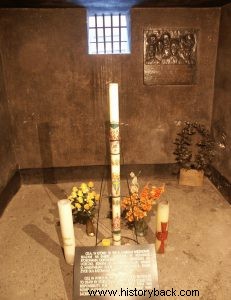
Maximilian Kolbe was born on January 8, 1894 in Poland, then occupied by the Russians. His father was a weaver and his mother a midwife. His father was German and his mother Polish. At the age of 12, he saw in a vision the Virgin Mary offering him two crowns, one white of purity and one red of martyrdom. So a little later, in 1907, he went to a monastery. In 1914 he became a monk.
He studied philosophy in Rome and even obtained a doctorate. In 1918 he was ordained a priest and a year later he returned to the now free Poland. He fell ill with tuberculosis and everyone thought he would not survive.
Nevertheless, he escaped and developed intense religious activity by establishing a church publishing house. Later, despite his permanent health problem, he became a missionary. He traveled to Asia, first to China and then to Japan where he also founded a monastery in Nagasaki, which was not destroyed when the city was hit by the American atomic bomb. He then went to India where he also founded a monastery. Due to his health, however, he was forced to return to Poland in 1936.
When the Germans invaded Poland he was one of the few who remained in the monastery. On September 19, 1939 he was arrested by the Germans. They released him on December 8 hoping that he would sign a declaration that he was German. He refused and tirelessly continued his work saving many, including 2,000 Jews.
On February 17, 1941, however, the Germans sealed the monastery and arrested him. On May 28 he was sent to Auschwitz. In the camp he was forbidden to officiate even briefly but he did not stop "winning" savage beatings and whippings. At the end of July 1941 a prisoner managed to escape.
The prisoner worked in the same group as Kolbe. When the Germans failed to discover the fugitive, SS Captain Karl Fritz, Auschwitz's deputy commandant, randomly selected 10 prisoners from the group for execution. But what execution? The 10 would be locked in a cell and left to die of hunger and thirst...
This punishment was devised by the perverted brain of the German to discourage escapes. One of those chosen was Polish Army Sergeant Franciszek Gazwonizek.
When the sergeant was led away with the other mortals, a human rascal, he completely lost his morale and began to cry bitterly and shout that his wife and children were waiting for him.
As the sergeant was still mourning, Father Maximilianos appeared courageously before the executioner and asked that he take the place of sergeant. The German did not refuse and the priest was put on death row with nine others.
The priest locked in the cell did not stop all the days that remained to pray and comfort the other mortals. One by one those locked in the cell died horribly with thirst burning their food and hunger crushing them.
Every now and then the German guards entered the cell and took away the dead watching the priest pray to bless the dead. In the end he was the last one left. On August 14, 1941, the Germans entered the cell and killed him with an injection of phenol.
The next day, August 15, the Feast of the Virgin Mary, they burned his body. Father Maximilianos had also received his second crown. The murderer of himself and hundreds of thousands of others, Captain Fritz disappeared in 1945.
According to some sources he was killed in Berlin. Other sources state that he died later.
Father Maximilian was accused of being anti-Semitic because of his articles in which he attacked Freemasonry and Communism, both of which he linked to Zionism.
However, his actions and the hospitality of Jews in his monastery show otherwise. Besides, in his articles, Kolbe echoed the point of view of the Roman Catholic church to which he also belonged.

The death cell in Block 11 of Auschwitz.
